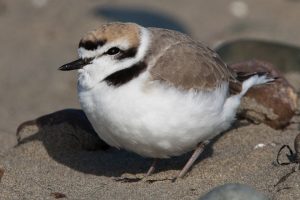For most weekenders and day-trippers, the allure of California’s Central Coast tapers off somewhere south of Pismo Beach.
Those folks are missing out.
Down the road, past the point where Highway 101 starts its climb into Santa Barbara County, endless rows of strawberries fill the air with the scent of fruit, rocket ships stand poised to leap at the stars, vineyards spread through hidden valleys, and fields of flowers march down to meet pristine beaches.
Treasures of the Sierra Madre
On the other side of the hills, nestled between spurs of the Sierra Madre Range to the north and the San Rafael Mountains to the south, spreads the fertile plain of the Santa Maria Valley. At its heart is Santa Maria–a thriving city of around 100,000–and surrounding it millions upon millions of berry plants grow neatly side-by-side.
The harvest tops one billion pounds–two-thirds of the strawberries produced in the state each year. The berries aren’t just endless, they’re nearly eternal. Santa Maria Valley’s gentle climate keeps them fruiting from early spring until late in the autumn alongside fields fat with beans and squashes, celery plants and sweet peas, broccolis, spinaches and cauliflower.
While berries fresh from the vine fill roadside stands year ’round, and the weather by the sea is nearly always nice, some highlights on the local calendar should not be missed.
Where the Flowers Meet the Sea
The temperate and constant weather that makes the soil of Santa Maria Valley so rich and the harvest so plentiful is a gift of the nearby Pacific Ocean. Long and nearly deserted beaches lie a short drive from Santa Maria. Tides rise and fall even closer to the historic town of Lompoc, and nearby Vandenberg Air Force Base–the West Coast’s spaceport–marches right down to the shore.
A handful of the fields surrounding Lompoc (pronounced lom-poke) are filled with flowers that bear no fruit. They bloom to please the eye and to remind the strawberry it wasn’t always king. Once a center of the flower seed industry, Lompoc’s brightly colored past is today central to a five-day, carnival-like celebration of a bygone heyday.
The city’s enterprising past blossoms to life during the June Flower Festival. Week-long festivities—live concerts, artisans, thrill rides and a down-home parade—fill the days leading up to the Independence Day weekend. See www.lompocvalleyfestivals.com for more.
Plovers by the Stagnant Waters
The term Lum Poc, from the language spoken by the Chumash who lived there by the sea before the Spanish came, translates as stagnant water. Today that stagnant water–a pristine lagoon at the heart of Ocean Beach Park–draws birdwatchers and nature photographers to its isolated shores during the few months between October and February, when the protected snowy plovers have left their nests.

Nearby Surf Beach, part of the Vandenberg State Marine Reserve, draws another kind of wildlife seeker. Surfers flock to the area once the plovers have flown. They come cautiously, however: great white sharks have killed twice there in recent years. It also hosts an automated, zero-frills Amtrak station that serves as a whistle stop for the Pacific Surfliner between San Luis Obispo and San Diego.
The Catholics who followed the Spanish explorers called the area La Misión la Purísima Concepción de María Santísima, and the complex they built still stands just outside Lompoc as La Purísima State Park. The former Franciscan Mission opens to visitors daily, except when it serves as backdrop to weddings and other private affairs.
Details are at www.parks.ca.gov and www.cosb.countyofsb.org/parks.
West Coast Space Center
Vandenberg Air Force Base surrounds those well-kept beaches, offering them some of the leftover Cold War-era protection it provided as the West Coast center for US military spaceflight operations. Overlooking the Pacific Missile Testing Range, rockets still roar to life there, soaring across the ocean for missile testing, hurtling their way into orbit, and one day soon crossing to Mars and other nearby planets.
Space enthusiasts come from around the globe to witness the spectacle of mankind’s most powerful machines, to feel a rumble like undertones in the voice of God, and watch the arcs of fire trace into the sky. The also come for a pilgrimage to the Vandenberg Space and Missile Heritage Center, inside the base at Space Launch Complex-10, where America’s first ICBM’s first flew.
Tours of the base can be arranged at www.vandenberg.af.mil. Launch dates and times are listed at www.spaceflight.now/launch-schedule.
King Strawberry
Hardworking Santa Maria, like Salinas to the north, is a center for vegetable farming, packing and processing of all sort. But, it’s the strawberry the city celebrates foremost. For three days each April, live music fills the air, carnival rides whirl and clang, and those sweet, sweet strawberries are eaten by the ton during the Santa Maria Valley Strawberry Festival.
More information is available at www.santamariafairpark.com.
Potent Potables
Santa Maria Valley also loves to indulge its romantic side. Nearly 7,500 acres in the foothills surrounding those miles of strawberry vines produce some of the finest wine California offers. Dozens of area vintners farm grapes as common as Chardonnay and as exotic as Tocai Fruilano, and twice a year they come together to celebrate the heady fruits of their labor.
The Santa Barbara Vintners Association Spring Weekend assembles its vintners and wine merchants for an extended Bacchanalian of food and drink, music, auctions and seminars, followed by more food and more drink. Between dining at the Big Bottle Bash, meeting winemakers during the Grand Tasting and learning their secrets at an evening of wine seminars, wine-lovers sample their fare at tasting rooms, historic wineries and vineyards throughout the county.
They do it all again in October at the Celebration of Harvest. Spring Weekend is held each April, and the Celebration of Harvest is held during the Columbus Day weekend. Details are on the events page at www. www.sbcountywines.com.
